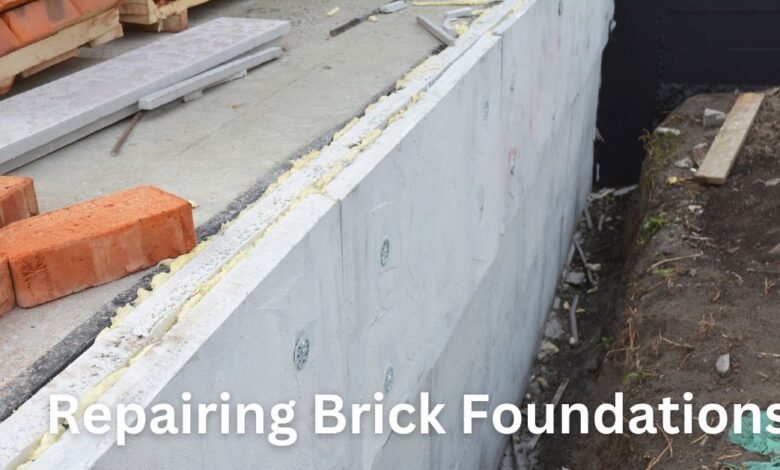
Introduction
A solid foundation is crucial for the structural integrity and safety of any building. Brick foundations, in particular, have been a popular choice for centuries due to their durability and strength. However, even the sturdiest brick foundations can develop issues over time, compromising the stability of the entire structure. In this article, we’ll delve into the intricacies of repairing brick foundations, exploring common signs of damage, underlying causes, effective repair techniques, and preventive maintenance strategies.
Signs of Brick Foundation Damage
Identifying signs of brick foundation damage early is essential for preventing further deterioration. Cracks in the foundation walls, particularly those wider than 1/4 inch, are a significant red flag. Additionally, doors and windows that no longer open or close properly, uneven floors, and gaps between the foundation and the structure are indicators of underlying issues. Interior signs such as cracks in drywall and sloping floors may also point to foundation problems. It’s crucial to conduct regular inspections to catch these signs early.
Causes of Brick Foundation Problems
Brick foundation damage can stem from various factors, both natural and man-made. One primary cause is soil movement, which can result from changes in moisture content, soil compaction, or expansive soil conditions. Poor drainage around the foundation can lead to excessive water accumulation, weakening the structure over time. Additionally, improper construction practices, such as inadequate reinforcement or substandard materials, can contribute to foundation issues. Understanding these causes is key to implementing effective repair and prevention measures.
Read more at https://blogrism.com/
Assessing the Damage
Assessing the extent of brick foundation damage requires a systematic approach. Visual inspection is the first step, where homeowners or professionals examine the exterior and interior of the foundation for signs of damage. Utilizing tools like levels and measuring tapes can help determine the severity of issues such as settlement or bowing walls. In some cases, advanced techniques like ground-penetrating radar or soil testing may be necessary to assess underlying conditions. A comprehensive evaluation ensures that the appropriate repair strategies are employed.
DIY Repairs vs. Professional Help
While some minor brick foundation repairs can be tackled by DIY enthusiasts, significant structural issues require the expertise of professionals. DIY methods like patching cracks with mortar or sealants may provide temporary solutions but often fail to address underlying causes. Professional contractors have the knowledge, experience, and specialized equipment to diagnose problems accurately and implement lasting repairs. Moreover, engaging professionals ensures compliance with building codes and safety standards, reducing the risk of further damage.
Common Repair Techniques
Repairing brick foundations involves a range of techniques tailored to specific issues. Tuckpointing, which involves removing deteriorated mortar and replacing it with fresh mortar, is commonly used to address mortar deterioration and cracks. Repointing goes a step further by completely removing and replacing damaged bricks along with the mortar joints. For more severe issues like bowing walls or settlement, methods such as underpinning, carbon fiber reinforcement, or helical pier installation may be employed. The choice of technique depends on factors like the extent of damage, structural stability, and budget considerations.
Hiring the Right Contractor
Selecting a reputable contractor is paramount for ensuring the success of brick foundation repairs. Homeowners should research local contractors, solicit multiple bids, and request references from past clients. It’s essential to verify credentials, including licenses, insurance coverage, and certifications. Additionally, reputable contractors provide detailed written estimates, clearly outlining the scope of work, materials used, and project timeline. Open communication and transparency throughout the repair process foster trust and ensure satisfactory outcomes.
Steps in Brick Foundation Repair Process
The brick foundation repair process typically begins with site preparation, including clearing vegetation, excavating around the foundation, and ensuring proper drainage. Depending on the chosen repair technique, contractors may need to stabilize the structure temporarily using shoring or bracing systems. Repairs often involve removing damaged bricks and mortar, addressing underlying issues like soil settlement or moisture intrusion, and restoring the foundation to its original condition. Quality control measures, such as proper curing of materials and post-repair inspections, are essential to ensure the longevity of repairs.
Preventive Maintenance Tips
Preventing future brick foundation damage requires proactive maintenance and vigilant observation. Homeowners should regularly inspect the foundation for signs of damage, paying attention to cracks, bulges, and moisture issues. Maintaining proper drainage by directing water away from the foundation through gutters, downspouts, and grading adjustments can prevent water-related damage. Installing a foundation drainage system, such as French drains or sump pumps, may be necessary in areas prone to groundwater infiltration. Additionally, avoiding landscaping practices that can exert pressure on the foundation, such as planting trees too close to the structure, can help preserve its integrity.
Get more about https://blogrism.com/brick-facade-restoration/
Case Studies and Success Stories
Real-life examples of successful brick foundation repairs provide valuable insights into effective repair strategies and outcomes. Case studies may include before-and-after photos, testimonials from homeowners or contractors, and descriptions of the repair process. Highlighting specific challenges encountered during the repair process and how they were addressed can offer valuable lessons for homeowners facing similar issues. Success stories demonstrate the transformative impact of professional restoration, restoring structural stability and peace of mind to homeowners.
Future Trends in Brick Foundation Repair
Advancements in construction technology and materials are shaping the future of brick foundation repair. Innovations such as advanced mortars, epoxy injection systems, and carbon fiber reinforcement techniques offer more durable and cost-effective solutions for addressing common foundation issues. Sustainable practices, including recycled materials and energy-efficient repair methods, aim to reduce the environmental footprint of repair projects. Moreover, ongoing research and development in the field of structural engineering continue to push the boundaries of what’s possible, promising safer, more resilient structures for future generations.
Conclusion
Repairing brick foundations is a multifaceted process that requires careful assessment, strategic planning, and skilled execution. By understanding the signs and causes of foundation damage, homeowners can take proactive steps to address issues promptly and effectively. Whether through DIY repairs or professional intervention, prioritizing the structural integrity of brick foundations ensures the longevity and safety of residential and commercial buildings alike.
FAQs (Frequently Asked Questions)
- How do I know if my brick foundation needs repair?
- Look for signs such as cracks wider than 1/4 inch, uneven floors, and gaps between the foundation and the structure. If you notice any of these issues, it’s advisable to consult a professional for inspection.
- Can I repair minor cracks in my brick foundation myself?
- Minor cracks can often be addressed with DIY solutions like patching compounds. However, it’s essential to monitor these repairs closely and seek professional help if the cracks worsen or recur.
- What factors can contribute to brick foundation damage?
- Soil movement, water infiltration, poor construction practices, and natural phenomena like soil erosion and seismic activity can all contribute to brick foundation problems.
- How long does it take to repair a brick foundation?
- The duration of repair work depends on the extent of the damage and the chosen repair techniques. Minor repairs may be completed in a few days, while extensive restoration projects can take several weeks.
- Is it possible to prevent future damage to my brick foundation?
- Yes, proactive maintenance measures such as monitoring moisture levels, addressing drainage issues, and maintaining proper grading can help prevent future brick foundation damage.




